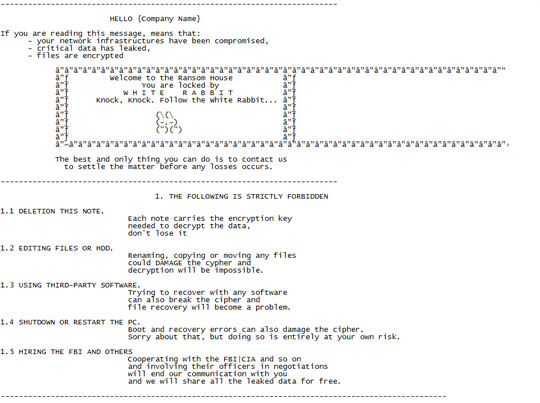Ransom.Win32.WHITERABBIT.YACAET
Windows


Threat Type: Ransomware
Destructiveness: No
Encrypted: Yes
In the wild: Yes
OVERVIEW
This Ransomware arrives on a system as a file dropped by other malware or as a file downloaded unknowingly by users when visiting malicious sites.
It drops files as ransom note. It avoids encrypting files with the following file extensions.
TECHNICAL DETAILS
Arrival Details
This Ransomware arrives on a system as a file dropped by other malware or as a file downloaded unknowingly by users when visiting malicious sites.
Installation
This Ransomware drops the following files:
- {Malware Directory}\{Filename from argument} → If -l was used.
It adds the following processes:
- cmd /c choice /t 9 /d y & attrib -h {Malware Filepath}\{Malware Filename} & del {Malware Filepath}\{Malware Filename}
It adds the following mutexes to ensure that only one of its copies runs at any one time:
- Global\{GUID}
Process Termination
This Ransomware terminates the following services if found on the affected system:
- msexchange*
- msex-change*
- vss
- sql
- svc$
- memtas
- mepocs
- sophos
- veeam
- backup
- gxvss
- gxblr
- gxfwd
- gxcvd
- gxcimgr
- defwatch
- ccevtmgr
- ccsetmgr
- savroam
- rtvscan
- qbfcservice
- qbidpservice
- intuit.quickbooks.fcs
- qbcfmonitorservice
- yoobackup
- yooit
- zhudongfangyu
- stc _ raw _ agent
- vsnapvss
- veeamtransportsvc
- veeamdeploymentservice
- veeamnfssvc
- pdvfsservice
- backupexecvssprovider
- backupexeca-gentaccelerator
- backupexecagentbrowser
- backupexecdivecimediaservice
- backupexecjobengine
- backupexecmanagementservice
- backupexecrpcservice
- acrsch2svc
- acronisagent
- casad2dwebsvc
- caarcupdatesvc
- vmwp
- back
- xchange
- ackup
- acronis
- enterprise
- acrsch
- antivirus
- bedbg
- dcagent
- epsecurity
- epupdate
- eraser
- esgshkernel
- fa_scheduler
- iisadmin
- imap4
- mbam
- endpoint
- afee
- mcshield
- task
- mfemms
- mfevtp
- mms
- msdts
- exchange
- ntrt
- pdvf
- pop3
- report
- resvc
- sacsvr
- savadmin
- sams
- sdrsvc
- sepmaster
- monitor
- smcinst
- smcservice
- smtp
- snac
- swi_
- ccsf
- truekey
- tmlisten
- ui0detect
- w3s
- wrsvc
- netmsmq
- ekrn
- ehttpsrvn
It terminates the following processes if found running in the affected system's memory:
- *sqlserver*
- agntsvc
- avp
- backup
- calc
- cntaosmgr
- dbeng
- dbeng50
- dbsnmp
- ekrn
- encsvc
- eshasrv
- excel
- firefox
- firefoxconfig
- infopath
- isqlplussvc
- kavf
- klnagent
- mbamtray
- mfefire
- msaccess
- msdtc
- mspub
- mydesktop
- mydesktopqos
- mydesktopservice
- mysql*
- notepad
- ntrtscan
- ocautoupds
- ocomm
- ocssd
- onenote
- oracle
- outlook
- pccntmon
- powerpnt
- sofos
- sqbcoreservice
- sqbcoreser-vice
- sql*
- steam
- synctime
- tbirdconfig
- thebat
- thunderbird
- tmlisten
- veeam
- virtual
- visio
- vmcomp
- vmcompute
- vmms
- vmsp
- vmwp
- wbengine
- winword
- word
- wordpad
- xchange
- xfssvccon
- zoolz
Other Details
This Ransomware does the following:
- It requires to be executed with the password/passphrase in order to proceed with its malicious routine:
- KissMe
- It will encrypt files found in the following set of drives in the affected system:
- Fixed Drives
- Removable Drives
- Network Drives and Resources
It accepts the following parameters:
- -p {password/passphrase}
- -f {file to encrypt}
- -l {logfile}
- -t {day}-{month}-{year} {hour}:{minute} → Use 24 Hour Format and 2 Digits
Ransomware Routine
This Ransomware avoids encrypting files with the following strings in their file name:
- *\desktop.ini
- *\thumbs.db
It avoids encrypting files with the following strings in their file path:
- c:\filesource\*
- c:\windows\*
- c:\programdata\*
- %User Temp%\*
- *:\sysvol\*
- *:\netlogon\*
- *:\windows\*
- *:\programfiles\*
- *:\program files (x86)\*
- *:\program files (x64)\*
(Note: %User Temp% is the current user's Temp folder, which is usually C:\Documents and Settings\{user name}\Local Settings\Temp on Windows 2000(32-bit), XP, and Server 2003(32-bit), or C:\Users\{user name}\AppData\Local\Temp on Windows Vista, 7, 8, 8.1, 2008(64-bit), 2012(64-bit) and 10(64-bit).)
It appends the following extension to the file name of the encrypted files:
- .scrypt
It drops the following file(s) as ransom note:
- {Encrypted Directory}\{Filename}.scrypt.txt

It avoids encrypting files with the following file extensions:
- *.scrypt.txt
- *.scrypt
- *.exe
- *.dll
- *.lnk
- *.iso
- *.msi
- *.sys
- *.inf
SOLUTION
Step 1
Trend Micro Predictive Machine Learning detects and blocks malware at the first sign of its existence, before it executes on your system. When enabled, your Trend Micro product detects this malware under the following machine learning name:
- Troj.Win32.TRX.XXPE50FFF052
Step 2
Before doing any scans, Windows 7, Windows 8, Windows 8.1, and Windows 10 users must disable System Restore to allow full scanning of their computers.
Step 3
Note that not all files, folders, and registry keys and entries are installed on your computer during this malware's/spyware's/grayware's execution. This may be due to incomplete installation or other operating system conditions. If you do not find the same files/folders/registry information, please proceed to the next step.
Step 4
Search and delete these files
- {Malware Directory}\{Filename from argument}
- {Encrypted Directory}\{Filename}.scrypt.txt
Step 5
Scan your computer with your Trend Micro product to delete files detected as Ransom.Win32.WHITERABBIT.YACAET. If the detected files have already been cleaned, deleted, or quarantined by your Trend Micro product, no further step is required. You may opt to simply delete the quarantined files. Please check the following Trend Micro Support pages for more information:
Step 6
Restore encrypted files from backup.
Did this description help? Tell us how we did.

